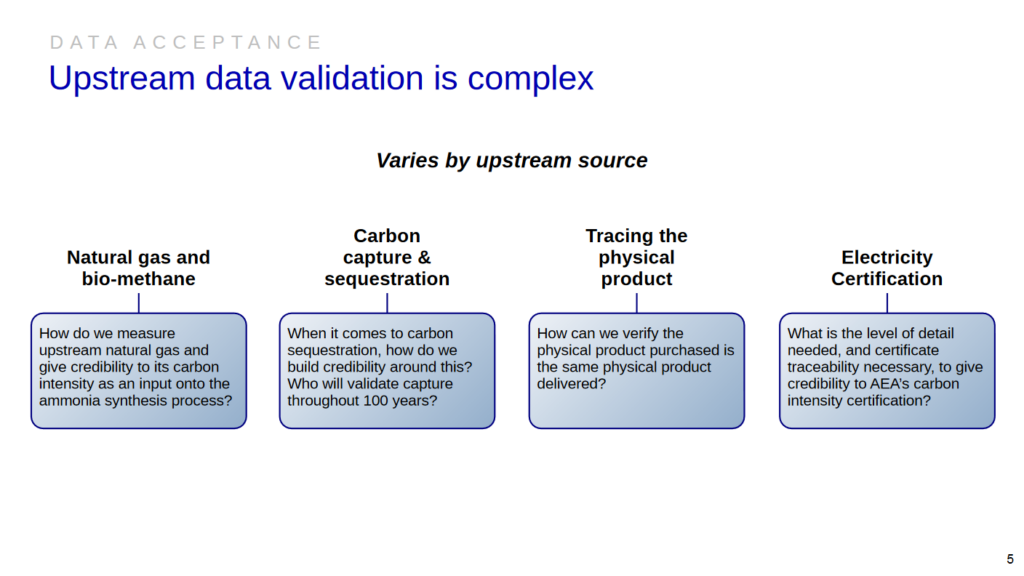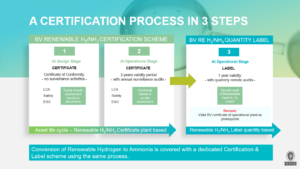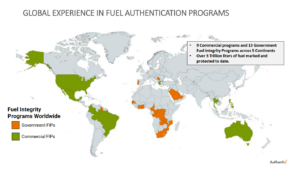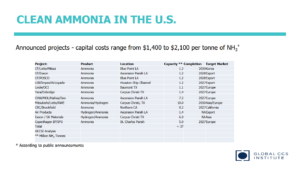Ensuring credible data inputs for ammonia certification
By Geofrey Njovu on November 26, 2023
The second day of the 2023 annual conference opened with a panel that explored the need for high quality data as an input to ammonia certification, moderated by AEA Treasurer and Starfire Energy Co-founder & COO Jennifer Beach. The panel featured Lara Owens of MiQ, Jim Seely of Authentix, Selim Cevikel of the Global CCS Institute and Rajiv Sabharwal of Bureau Veritas.
This issue is a key focus for the AEA, as our under-development ammonia certification system will require auditable data from a host of stakeholders – including gas and electricity suppliers, CO2 offtakers, and others – to calculate a true and trustworthy carbon footprint. For some inputs there are well-established standards (although these might not be globally consistent), but for other inputs satisfactory data is difficult to collect as it stands today. And even with high quality inputs, some markets will require a higher level of assurance, such as physical verification layers in addition to digital certificates.

Click to enlarge. Key considerations for data validation for CCS-based and renewable ammonia production. From Jennifer Beach, Ensuring upstream certification data quality (Nov 2023).
For this discussion, we invited some key perspectives. MiQ has developed its own rigorous standards for monitoring emissions from the oil & gas industry, providing a possible solution for the issue of fugitive methane emissions, enabling ammonia producers to account for upstream emissions of certified natural gas. Authentix already provides chemical markers in multiple fuel verification schemes globally, and sees clear applications for ammonia. Bureau Veritas has just launched its own renewable hydrogen certification scheme, and has examined closely the challenges around international trading of molecules produced using regionally-certified electricity. And while the Global CCS Institute is working to ensure the current pipeline of “blue” projects is realised in the USA, there is a need for global standards – currently lacking – to support scale-up around the world.
Upstream validation is complex

Click to enlarge. Key data quality indicators for methane monitoring. From Lara Owens, Impact of Methane on Natural gas and data quality (Nov 2023).
The challenges for upstream data validation depend entirely on the energy input. For gas and bio-methane, how exactly do we capture emissions intensity and give credibility to the values? For electricity, what level of detail is needed and what kind of traceable certificates will need to be presented? Building off the work done by others is critical, with MiQ and Bureau Veritas indicating a possible way forward for both these considerations.

Click to enlarge. BV’s multi-step certification process for renewable hydrogen & ammonia, with data inputs and surveillance requirements increasing stepwise. From Rajiv Sabharwal, Bureau Veritas: Hydrogen & Ammonia certification scheme & label (Nov 2023).
MiQ’s methane emissions monitoring is based on a unique, segregated governance structure to avoid conflict of interest. The use of third party auditors (who undergo annual review processes) is recommended, as is a range of methane monitoring equipment. For electricity certification, BV has designed a multi-step certification scheme based on multiple ESG pillars, a carbon footprint threshold, and the option of project developers to “layer up” certification of their product at different stages of their project.
Cradle to grave
To support consistency and comparability of data, the panel coalesced on the importance of always supporting a “cradle to grave” boundary for carbon footprinting. For example, gate-to-gate product data, omitting upstream fugitive methane or the carbon intensity of electricity, would not be sufficient inputs for a well-to-gate certification system, such as the one the AEA is developing.
Integrity and authentication

Click to enlarge. Existing fuel integrity programmes, with valuable insights for emerging ammonia certification schemes. From Jim Seely, Ammonia Authentication as a Key Component of the Certification Framework (Nov 2023).
While third-party auditing is critical to building credibility, fraudulent behaviour might be inevitable any time there is a price difference, whether this is between jurisdictions, between markets, or between identical batches of ammonia with different environmental attributes. Valuable insights can be learned from existing fuel integrity programs.
Global harmonisation

Click to enlarge. The pipeline of CCS-based ammonia projects under development in the USA. From Selim Cevikel, Clean Ammonia in the U.S. (Nov 2023).
When calculating the carbon footprint of ammonia produced using carbon capture technology, permanent sequestration of CO2 (CCS) is simpler than utilisation (CCU) . But even for CCS, there has been a lack of agreement on key terms and on what data is important. Without this, it will be a challenge to develop the cross-jurisdictional standards for CCS that might ultimately underpin certification schemes for CCS. Nonetheless, the aim must continue to be towards developing globally harmonised standards for CCS.
The value of certification
Discussion unearthed more important points and further drove home the importance of accounting for steps that are far upstream and downstream of ammonia production. Good certification schemes should provide quality assurance around assets, equipment, and the supply chain, supported by independent testing and measurement with third-party audits. The added cost and effort of this approach is more than offset by the extra value provided to producers and consumers.